Belize Tours & Adventures with Trained Jungle Guides
“We had a great day exploring with Pacz Tours.”
5/5

Pacz Tours
Crafting Exceptional Adventures Since 1996
Menu
Belize Tours & Adventures with Trained Jungle Guides
“We had a great day exploring with Pacz Tours.”

Crafting Exceptional Adventures Since 1996
Explore the rich wildlife of Belize, as we discover that this Central American gem is teeming with fascinating creatures. From its lush rainforests to its pristine coastal waters, Belize offers a home to a variety of remarkable animals, each playing a vital role in keeping the environment balanced.
The rainforest in Belize is a world of its own, unlike any other place on Earth. Here, you can find over 145 mammals including jaguars, monkeys, tapirs and The West indian manatee thriving in their natural habitats. Moreover, over 400 species of birds flit and soar above, presenting a vibrant tapestry of avian life. Amidst the green canopy, you’ll discover thousands of plants and tropical flowers, including the breathtaking beauty of 100 orchid types and an astonishing 1,100 tree species.
Experience the wonders of Belize, where wildcats, colorful birds, and exotic flora come together to offer an unparalleled wildlife encounter. As you explore the pristine coastal waters, be amazed by the marine marvels that contribute to Belize’s incredible biodiversity.
Within the Belize Wildlife Encounter, let’s explore 13 of the most notable animals that call this nation home. Witness the elusive jaguars silently prowling through dense foliage, or catch a glimpse of majestic tapirs roaming the rainforests and Jungles. Ancient reptiles like crocodiles thrive in their habitats, showing the resilience of Belize’s ecosystems.
The Baird’s Tapir, scientifically known as Tapirus bairdii, proudly holds the title of the largest land mammal in Central America. This majestic creature gracefully roams the verdant rainforests and marshy areas of Belize. Weighing between 300 to 500 pounds and measuring up to 6 feet in length, the Baird’s Tapir boasts an impressive presence. With an average lifespan of up to 22 years, they contribute significantly to the ecosystem’s health and vitality.
The Baird’s Tapir plays a vital role in forest regeneration as they actively disperse seeds and shape the landscape through their natural movements. Notably, this endearing animal holds special significance as one of Belize’s National Animals, symbolizing the country’s commitment to wildlife conservation.
For an unforgettable encounter with these remarkable creatures, the Belize Zoo offers an excellent opportunity to get up close and personal with tapirs. Witnessing the Tapir’s grace and charm in its natural environment is an experience that leaves a lasting impression on visitors, making the zoo a must-visit destination for wildlife enthusiasts and nature lovers alike.
The Howler Monkey, scientifically known as Alouatta, is a captivating creature that leaves a lasting impression on anyone who ventures into the dense rainforests of Belize. Their haunting calls resonate through the canopy, announcing their presence to travelers and locals alike. In fact, the Howler Monkey’s call is so powerful that it can be heard up to 3 miles (4.8 kilometers) away, earning it the title of the loudest animal in the country.
These vocal primates play a crucial role in the ecosystem, contributing significantly to seed dispersal, which aids in forest regeneration, and helping to maintain the delicate ecological balance of Belize’s rainforests.
For a remarkable experience with these loud and charismatic creatures, two excellent places to get up close are the Community Baboon Sanctuary www.howlermonkey.org in Northern Belize and the Monkey River tour in Southern Belize. Both locations offer opportunities to observe Howler Monkeys in their natural habitat, allowing visitors to witness their fascinating behaviors and hear their resounding calls.
Another exciting opportunity to encounter monkeys in the wild is during a visit to the Xunantunich Mayan Ruins. As you explore the ancient ruins, keep an eye out for troops of Monkeys swinging gracefully through the treetops, adding a touch of wild beauty to the historical site.
The scarlet macaw or Are Macao, vibrant and charismatic, stands as a symbol of Belize’s avian diversity. Its stunning red, blue, and yellow plumage paints a breathtaking picture as it soars gracefully through the skies, leaving an unforgettable mark. For bird enthusiasts, wildlife lovers, or those with an appreciation for endangered animals, a visit to Red Bank Village in Southern Belize becomes an essential part of an enriching journey.
Observing the scarlet macaws in their natural habitat is a rare treat. Like many other birds, these majestic creatures migrate southward during the winter months, ensuring their survival. Interestingly, the period between November and March coincides with an abundant supply of delectable fruits flourishing amidst the lush greenery of the region. This bounty of nature provides the scarlet macaws with a delightful feast, making it a splendid sight for lucky onlookers.
The sight of scarlet macaws in flight, nourishing themselves from the abundant fruits, creates a lasting impression that lingers in the hearts of all who witness it. For an enriching and unforgettable experience of Belize’s local wildlife, a rendezvous with the scarlet macaws of Red Bank Village is an absolute must.
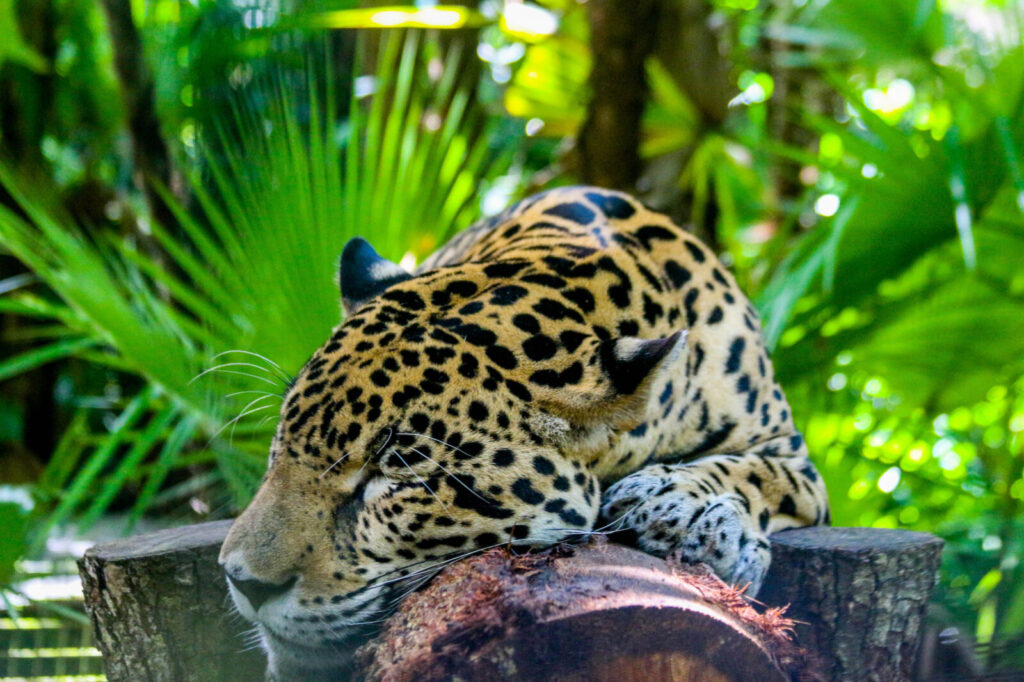
Jaguar (Panthera onca): As the apex predator of the Belizean jungles, the elusive jaguar reigns supreme. With its powerful build and distinctive rosette-patterned fur, this big cat commands respect and embodies the spirit of wilderness. This animal is mostly seen on the southern parts of Belize.
For Belize wildlife enthusiasts eager to see these remarkable animals in their natural habitats, the country offers a plethora of opportunities. Nature reserves, such as the Community Baboon Sanctuary and Cockscomb Basin Wildlife Sanctuary, are excellent places to witness a variety of wildlife, including coatimundis, kinkajous, and agoutis.
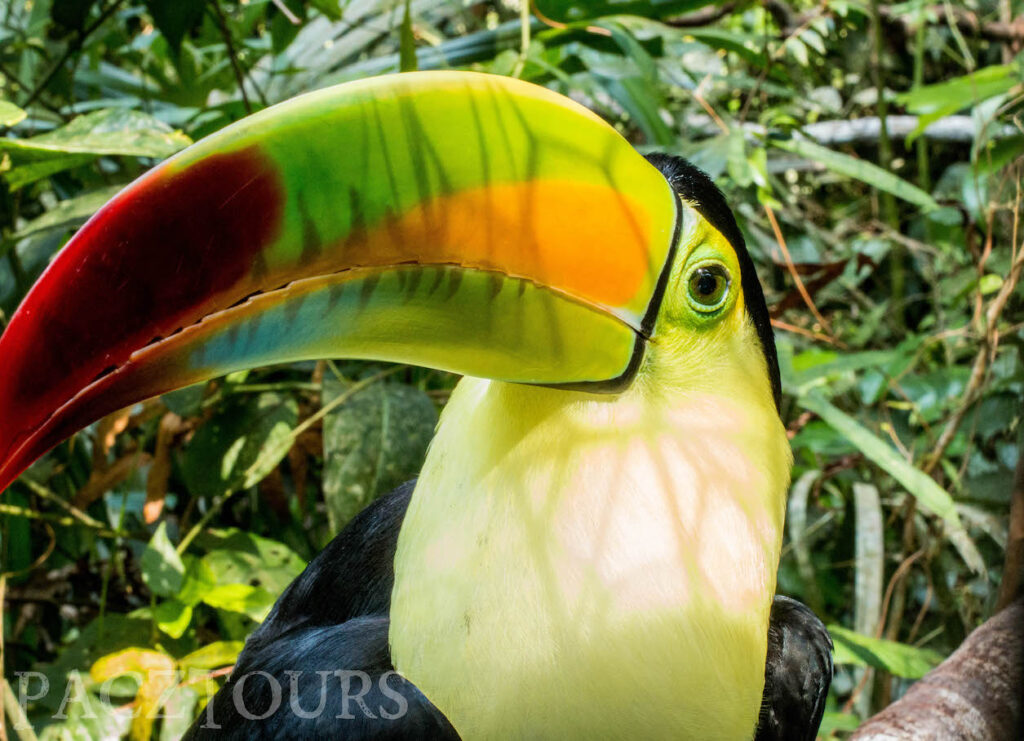
The Keel-billed Toucan (Ramphastos sulfuratus), a vividly colored and captivating creature, graces the rainforests of Belize with its tropical allure. Also known as the sulfur-breasted toucan, keel toucan, or rainbow-billed toucan, this lively member of the toucan family represents the vibrant spirit of Latin America. Notably, it holds the esteemed title of being the national bird of Belize, a symbol of pride for the nation.
Inhabiting the lush rainforests, these toucans have an interesting habit of sleeping in hollow trees, sometimes with multiple adults cozily huddled together in one sleeping spot. Their social nature extends beyond their nighttime arrangements, as they often live in flocks of up to 22 individuals, making their presence a true spectacle in the wild.
Despite their short and heavy wings, Keel-billed Toucans are remarkably agile, preferring to hop from branch to branch rather than flying long distances. Their characteristic bill comes into play during feeding, where they display impressive dexterity. Grasping items like berries and insects with the tip of their bill, they deftly flick the food into the air, effortlessly catching it, and then swallowing it whole.
Observing these striking toucans amidst the verdant canopy of Belize’s rainforests offers a glimpse into the wonders of nature. Their vivacious plumage and unique behaviors add to the allure of this tropical paradise, captivating both locals and visitors alike. With their unmistakable charm, the Keel-billed Toucans bring a splash of vibrant colors to the rich tapestry of Belize’s wildlife.
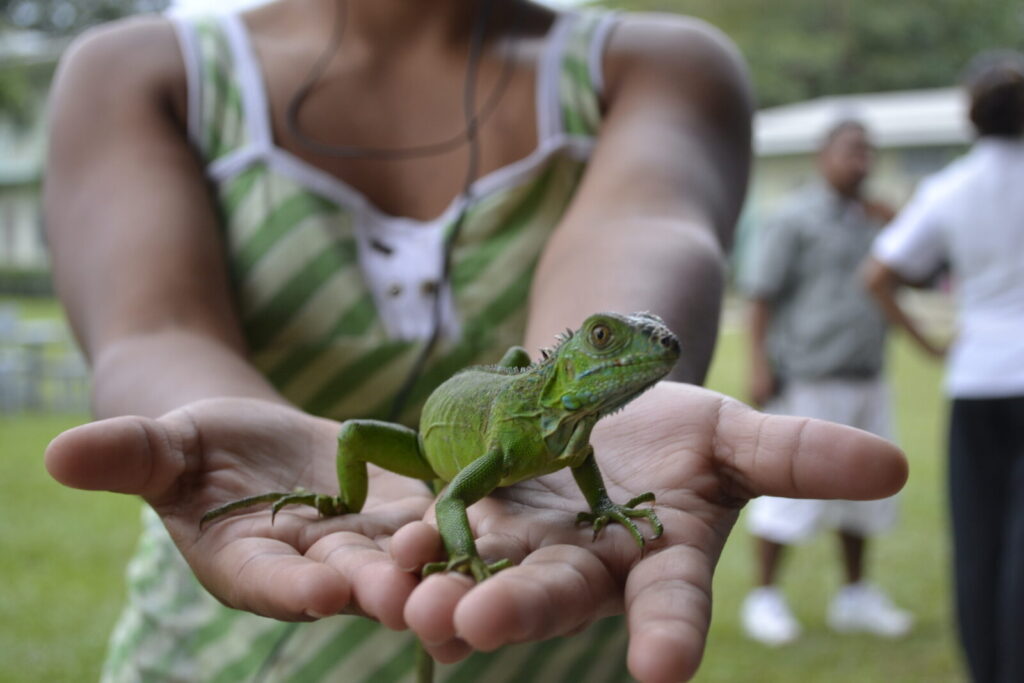
Green Iguana (Iguana iguana): Abundant in Belize, the green iguana basks in the sun, regulating its body temperature and showcasing its prehistoric charm. If you are staying near a river there is a 90% chance that will see a green iguana, if you know what to look for.
Get a hands-on experience at the iguana conservation project in San Ignacio.
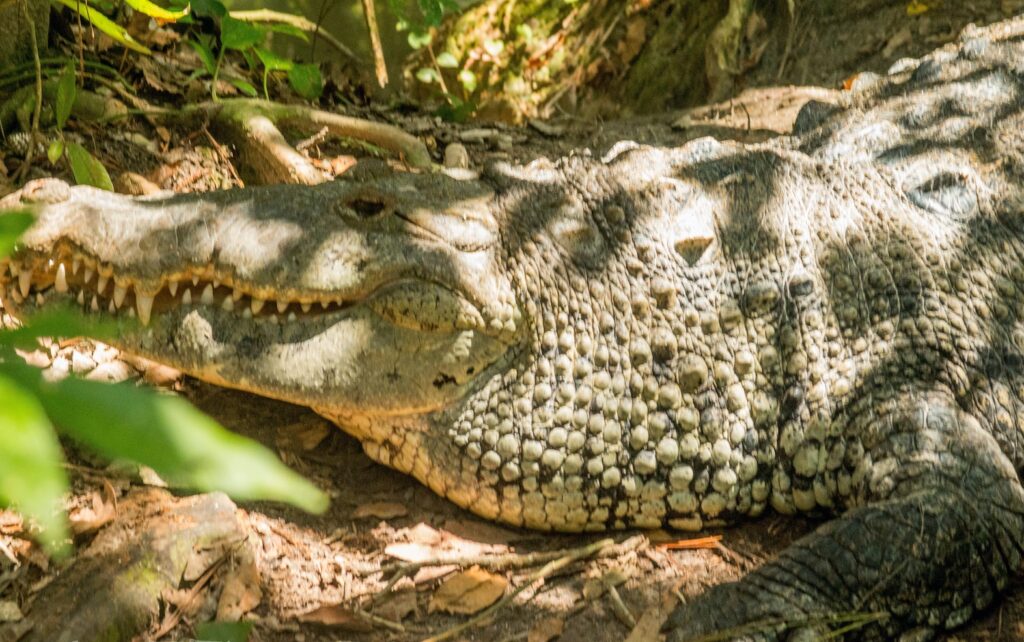
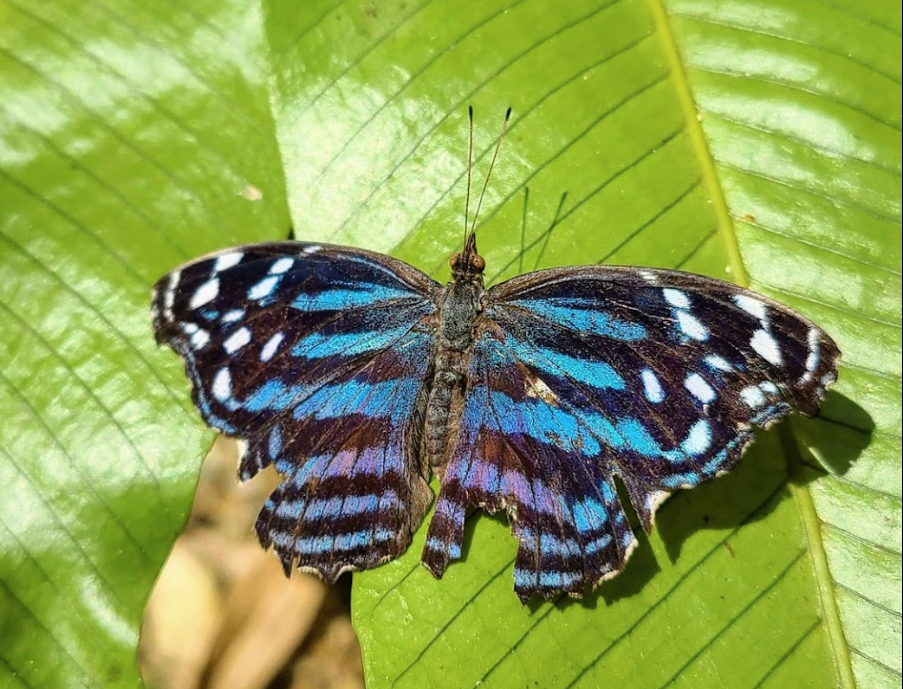
Loggerhead Sea Turtle (Caretta caretta): Belize’s coastline serves as a nesting ground for loggerhead sea turtles, where they lay their eggs in the sandy shores. The conservation efforts to protect these endangered creatures are of paramount importance.
You have a 90% chance of seeing loggerhead sea turtle and green see turtle snorkeling at the Silk Caye Marine Resever or at scuba Diving at Lighthouse Reef Atoll
Queen Triggerfish (Balistes vetula): Among the vibrant coral reefs of Belize’s Barrier Reef, the queen triggerfish stands out with its intricate patterns and bold colors, delighting divers and snorkelers alike.
Belize takes marine conservation seriously, especially with its remarkable Barrier Reef, a UNESCO World Heritage site. The country has established marine reserves and protected areas to conserve critical habitats for marine life. By promoting sustainable fishing practices and restricting harmful activities, Belize actively participates in preserving its coastal regions and the marine species that depend on them.
© 2024 PACZtours.net. All rights reserved. Sitemap – Privacy Policy – Terms -:- Photos by: 501Boyz Production & Esoteric Vision
| Cookie | Duration | Description |
|---|---|---|
| cookielawinfo-checkbox-analytics | 11 months | This cookie is set by GDPR Cookie Consent plugin. The cookie is used to store the user consent for the cookies in the category "Analytics". |
| cookielawinfo-checkbox-functional | 11 months | The cookie is set by GDPR cookie consent to record the user consent for the cookies in the category "Functional". |
| cookielawinfo-checkbox-necessary | 11 months | This cookie is set by GDPR Cookie Consent plugin. The cookies is used to store the user consent for the cookies in the category "Necessary". |
| cookielawinfo-checkbox-others | 11 months | This cookie is set by GDPR Cookie Consent plugin. The cookie is used to store the user consent for the cookies in the category "Other. |
| cookielawinfo-checkbox-performance | 11 months | This cookie is set by GDPR Cookie Consent plugin. The cookie is used to store the user consent for the cookies in the category "Performance". |
| viewed_cookie_policy | 11 months | The cookie is set by the GDPR Cookie Consent plugin and is used to store whether or not user has consented to the use of cookies. It does not store any personal data. |